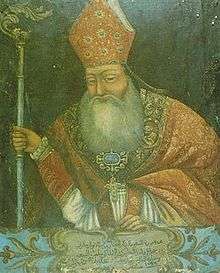Michael Fadel
Michael II Fadel (born in 1710 in Beirut, Lebanon - died on May 17, 1795 in Dayr Harrash, Lebanon), (or Mikhail Fadil, Arabic: ميخائيل الثاني فاضل), was a Lebanese priest and Maronite Archeparch of the Maronite Catholic Archeparchies of Tyre and Beirut and 64th Patriarch of Antioch from 1793 to his death in 1795. He died at Dayr Harrash, Lebanon.
His Beatitude Michael II Fadel (ميخائيل الثاني فاضل) | |
|---|---|
| Patriarch of Antioch | |
 | |
| Church | Maronite Church |
| See | Patriarch of Antioch |
| Elected | September 10, 1793 |
| Term ended | May 17, 1795 |
| Predecessor | Joseph Estephan |
| Successor | Philip Gemayel |
| Orders | |
| Consecration | 1762 (Bishop) by Tobias El Khazen |
| Personal details | |
| Born | 1710 Beirut, Lebanon |
| Died | May 17, 1795 (aged 84–85) Dayr Harrash, Lebanon |
Life
Michael Fadel was born in Beirut, Lebanon in 1710.[1] Ordained priest at 21 years, from 1741 to 1753 he served the community of Acre where he erected a church.[2] In 1754 he converted to Christianity the first member of the governing Shihab family. In 1762 Michael Fadel was appointed and consecrated bishop of Tyre and Patriarchal Vicar by Patriarch Tobias El Khazen,[3] who later appointed him also bishop of Beirut in place of Joseph Estephan.
After 1766, under the patriarchate of Joseph Estephan, Michael Fadel sided with the opponents to the Patriarch led by the Khazen Sheikhes, and he was one of supporters of the suspension of the Patriarch from 1779 to 1784, due to the Hindiyé's issue. Patriarch Estephan, in turn, appointed in 1768 Athanase Scenai and later in 1779 Joseph Najm (or Nujaym) in his place as bishop of Beirut. The solution of the dispute about the see of Beirut occurred only in the synod of 1786 where an agreement was found and Michael Fadel was confirmed as bishop of Beirut.[4]
Patriarch Joseph Estephan died on April 22, 1793, reconciled with Rome, but because of a pestilence the bishops could meet only in September. On September 10, 1793[5] Michael Fadel was elected Patriarch and choose to reside in the monastery of Dayr Harrash (in Keserwan District). Fadel send to Rome the priest George Ghanem, to obtain confirmation of the pope of his election. However, when Ghanem arrived in Rome, Fadel had already died on May 17, 1795 at Dayr Harrash, where he was buried,[6] before the Vatican could confirm him.
However in the consistory of 27 June 1796, which confirmed the election of his successor Philip Gemayel, Pope Pius VI mentioned the name of Fadel on the list of the Maronite Patriarchs.[7]
See also
- Maronite Church
- Joseph Estephan
- List of Maronite Patriarchs
Notes
- Graf, Georg (1960). "108.2 Micheal Fadil". Geschichte der christlichen arabischen Literatur, Volume 3. Biblioteca Apostolica Vaticana. p. 463.
- Louis Wehbe (2001). "The Maronite of the Holy Land". Journal of Maronite Studies. Maronite Research Institute. 5 (2). Archived from the original on 16 July 2011. Retrieved 23 February 2011.
- "Portrait of Patriarch Mikhael Fadel". OneFineArt. Retrieved 23 Febr 2011. Check date values in:
|accessdate=(help) - de Clercq, Charles (1949). Histoire des conciles d'après les documents originaux, Tome XI Conciles des Orientaux Catholiques. 1. Paris: Letouzey et Ané. pp. 283, 302.
- [The date of September 20 is shown from the consistory of 1796 and Eubel; other sources say 10 September, including the consistorial allocution of Pius VI in 1796.]
- Dau, Butros (1984). Religious, cultural and political history of the Maronites. Lebanon. p. 570.
- books.google.it
External links
- http://www.catholic-hierarchy.org/bishop/bfadelm.html, catholic-hierarchy.org
- Pierre Dib, v. Maronite (Eglise), in https://archive.org/stream/dictionnairedet10pt1vaca#page/n57/mode/2up, Tome Dixième, première partie, Paris 1928, coll. 100-101.
- Giuseppe Simone Assemani, https://archive.org/stream/serieschronologi00asseuoft#page/40/mode/2up, Roma 1881, p. 41.
- Konrad Eubel, Hierarchia Catholica Medii Aevi, https://archive.org/stream/hierarchiacathol06eubeuoft#page/87/mode/1up, vol. 6, p. 87.